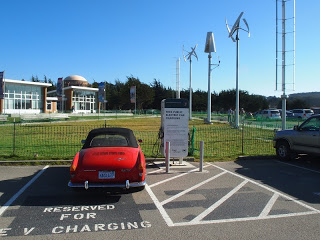Mostly electric car charging in the U.S. is free, as in zero cost to the consumer. There is of course a cost to buy the charging station, install it, get permits to install, etc. The businesses who install charging stations need to recoup their investment – there needs to be a viable business model for operating charging stations so that charging station networks exist far into the future. Electric car owners should not have their travel distance limited to a circle around their home that’s 1/2 the total driving range of their car.
There’s always been a bit of a backlash when a charging station switches from “free” to charging a fee. It seems to me that most people grow accustomed to free EV charging, expect that perk to continue forever, and get upset when their free charging perk is taken away.
I think the need for a viable business model outweighs the fun perk it is to drive for free. Me, personally, will be happy to pay a bit for the electricity I gather from a public charging station. However, some of the fees being charged by the charging network operators are rather out of line considering the cost of electricity or the relative value you’re getting compared to buying gas in a gas car. That is, frequently the cost to charge at a public station is higher per mile than traveling on gasoline. The word “gouge” comes to mind in some cases.
In most cases the free charging stations were free because of a government grant that paid for installation and electricity. Soon as the grant runs out, the host site wants to instigate a fee for usage.
Another question is what should happen to stranded charging stations. That is, some of the charging station network operators won’t survive the current phase of electric car deployment. Blink / ECOtality, your name is high on that list of likely-to-die charging station networks.
ECOtality was the administrator of the EV Project, and in that role installed thousands of charging stations in the public and in peoples homes. The purpose from the US Government perspective was to collect usage data that will be useful for future planning. It meant that ECOtality became dependent on government handout, and never had to learn how to operate as a self-sustaining business. ECOtality recently signaled an intent to file for bankruptcy protection citing in part an inability to shift from government-supported to normal commercial entity![]() .
.
If ECOtality dies what will happen to all the Blink chargers installed everywhere? Will they just be abandoned? Okay, the Blink stations are likely to be auctioned as an asset, and some other entity will operate them. But it’s possible the Blink stations will just be abandoned, and if so then what? In other words, if ECOtality had been pushed to have a viable business model earlier, rather than surviving on government handout, they could have been a stronger company.
ECOtality started a process to begin charging fees to use their stations – $1/hr for a regular station, and IIRC $5/hr to use a fast charging station. But it’s my impression that Blink usage dropped off a lot after that change.
It doesn’t help that the Blink stations are often broken.
In any case here’s a few thoughts on how to keep EV charging in a “zero cost to the consumer” model while still being a viable business model. These aren’t anything more than brain farts but I would be curious for pointers on whether these ideas are truly viable:
Advertising display panels: As much as advertising is a bane of modern life, it has enabled so many modern services to exist. I provide a space on this blog, for example, where advertisers pitch their wares, and hopefully the advertising brings in enough revenue to pay me enough to keep writing these blog posts. The same could hold true at EV charging stations. The display panel could serve double duty to display instructions to users of the charging station.
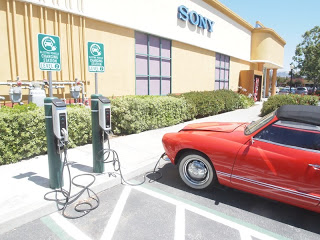 |
| SemaCharge station in Gilroy, CA Location is a large outlet mall with lots of shopping and restaurants It’s also a critical location for anyone taking a long trip out of the SF Bay area |
Businesses derive benefit: It’s extremely well understood that a business which installs a charging station usually sees more traffic in their store. I certainly feel better about the Hayward Walgreens for installing a ChargePoint charging station than I do about other stores near that location, for example. In theory that means the EV owner will frequent stores with charging stations, and additionally spend more time in the store and be more likely to buy more stuff.
Donated charging stations: The derived benefit may not be enough to pay for the charging station. Installation costs can be steep and depend on factors like how far from the building trenches have to be dug, or whether the charging station requires a dedicated Internet connection, and more.
Instead of those expenses some operators (well – one – Sun Country Highway![]() ) has built a huge network of charging stations in Canada, and is starting to spread into the U.S. Their model is for individuals to sponsor charging stations, which are installed at a business location. The stations are free to use and there isn’t even a membership card of any kind.
) has built a huge network of charging stations in Canada, and is starting to spread into the U.S. Their model is for individuals to sponsor charging stations, which are installed at a business location. The stations are free to use and there isn’t even a membership card of any kind.
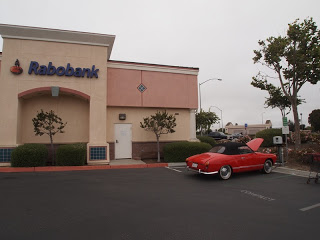 |
| Rabobank / Tesla charger in Salinas CA No authentication required Supports 70-80 amp charge rates Project funded by Tesla and Solar City in 2010ish |
The thing is, the electricity has negligible cost, and by not having an authentication process the installation cost is reduced. Therefore this ties with the Businesses derive benefit model in a way that encourages businesses to participate where the hassles of other kinds of charging stations drive businesses away.
Manufacturer owned charging networks: Tesla and Nissan both are working hard to set up fast charging station networks that they themselves own. The incentive for the manufacturer is that it acts to increase sales of their cars.
In Tesla’s case they’re building their own stations at rest stops and similar places along the highways. These locations are usually useful, with interesting destinations nearby.
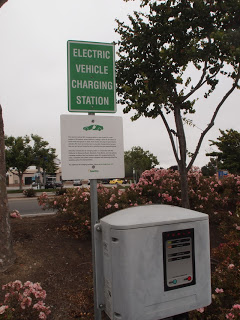 |
| Close-up of the Rabobank station above It’s just a Clipper Creek CS80 No authentication of any kind |
In Nissan’s case the stations are going in at Nissan dealerships. That means the status of those stations is not as clear-cut as the fully Tesla owned stations. The usage arrangements at each dealership could be different. The only one I’ve inspected in person, at Boardwalk Nissan in Redwood City, the user had to get a token from the dealership office then drive down the street to use the station. I envision that in some cases the charging station might be hidden in the back or otherwise have access limited to business hours.
The problem I see with this model is it encourages proprietary charging connectors. That then has the effect of fracturing the electric car charging infrastructure and we know from past experience that is a painful route to follow.
Reduce cost of authorization system: Having a fancy authorization system – you know, swiping a card or something – means having to form a membership relationship with the charging station operator, usually. Any kind of card reader and communication with back-end office systems means that Internet connectivity is required at the charging station location. There’s a lot of points of failure, and it increases the cost of the station as well as the number of wires that have to be brought out to the station as well as provisioning an internet connection for the station. Before you say WiFi or 3G Cellular connections for the stations (to avoid wires) these are flakier than hardwired internet connections. For example 3G cellular is less likely to work well deep inside a parking garage in the basement of a tall office building. Right?
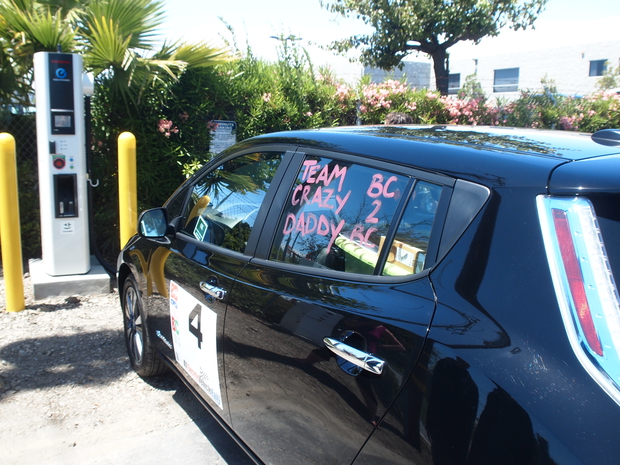 |
| Nissan DC Fast Charger at a Nissan dealership (Boardwalk Nissan) this charger requires a token you get inside the dealership, and then you drive down the street to the charger location |
One idea would be to use the customer’s smart phone as the intermediary for authentication, rather than internet connectivity built into the station. The station might have some kind of near-field-communication (NFC) support or RFID or whatever such that a QR code is printed on the station, with the smart phone you scan the QR code and a smart phone app then somehow cooks up an authentication code that’s transmitted as NFC or RFID or something.
Ah.. there’s a generalized version of this problem having to do with payments at vending machines. The charging station can be viewed as just a kind of vending machine.
In any case – the end-goal would be to have authentication at the charging station without requiring anything fancy at the charging station.
 |
| A QR code based system planned by Hubject/Intercharge for use in Europe to interconnect charging networks |
The way I discussed it above does force a requirement that everyone own a smart phone. Not everybody does, however. And there’s the same issue with connectivity deep inside a parking garage.
Coin slot: Another version of low cost authentication is a simple coin slot. This method is so inexpensive that cities all over the U.S. have coin slot operated parking meters and it works great.
What if a city were to be able to install a combination parking meter and free EV charging unit, that has a simple coin slot, and enforcement similar to current parking meter enforcement today?
Offer smart grid services: If the charging station owner could derive their own benefit from the charging station infrastructure, they could give the electricity away as an incentive to get cars to be plugged into the charging station.
Consider a charging station installation that incorporates a grid energy storage unit (large battery pack) and, if feasible, a large solar panel array. With smart grid services the owner of a grid energy storage unit can (or will be able to in the future) earn revenue from offering grid electricity stabilization services. Namely, Demand Response where the grid operator can send out signals to draw more or less electricity out of the grid in order to stabilize the grid.
The solar panel array could be big enough to generate more electricity than is required to charge electric cars, and the station operator could sell that electricity back to the grid. The grid energy storage unit needs to be big enough to handle charging cars directly rather than to hit the grid at full rate for the cars that are charging. The storage unit also acts as a demand-response object, so the charging station operator can earn their revenue. When cars are plugged into a charging station, well to future charging stations, in theory the idea is for the charging stations to be sending smart grid commands to the car so that each car connected to a charging station becomes part of a giant grid energy storage unit with which the charging station operator can earn revenue.
Tax Writeoff (update): This idea came from a Facebook comment![]() … The observation is that free charging is a good promotional tool. Hence, it could be written off on the taxes the same way window signs and other advertising material is. That is, the government could set up a tax break for businesses that put in charging stations for public use, and account for the expense as an item in the calculation of profit/loss. As it is, I believe it would be accounted for as a business asset which would add to the total assets of the company and be written off over time.
… The observation is that free charging is a good promotional tool. Hence, it could be written off on the taxes the same way window signs and other advertising material is. That is, the government could set up a tax break for businesses that put in charging stations for public use, and account for the expense as an item in the calculation of profit/loss. As it is, I believe it would be accounted for as a business asset which would add to the total assets of the company and be written off over time.
- Highway design could decrease death and injury risk, if “we” chose smarter designs - March 28, 2015
- GM really did trademark “range anxiety”, only later to abandon that mark - March 25, 2015
- US Government releases new regulations on hydraulic fracturing, that some call “toothless” - March 20, 2015
- Tesla Motors magic pill to solve range anxiety doesn’t quite instill range confidence - March 19, 2015
- Update on Galena IL oil train – 21 cars involved, which were the supposedly safer CP1232 design - March 7, 2015
- Another oil bomb train – why are they shipping crude oil by train? – Symptoms of fossil fuel addiction - March 6, 2015
- Chevron relinquishes fracking in Romania, as part of broader pull-out from Eastern European fracking operations - February 22, 2015
- Answer anti- electric car articles with truth and pride – truth outshines all distortions - February 19, 2015
- Apple taking big risk on developing a car? Please, Apple, don’t go there! - February 16, 2015
- Toyota, Nissan, Honda working on Japanese fuel cell infrastructure for Japanese government - February 12, 2015









